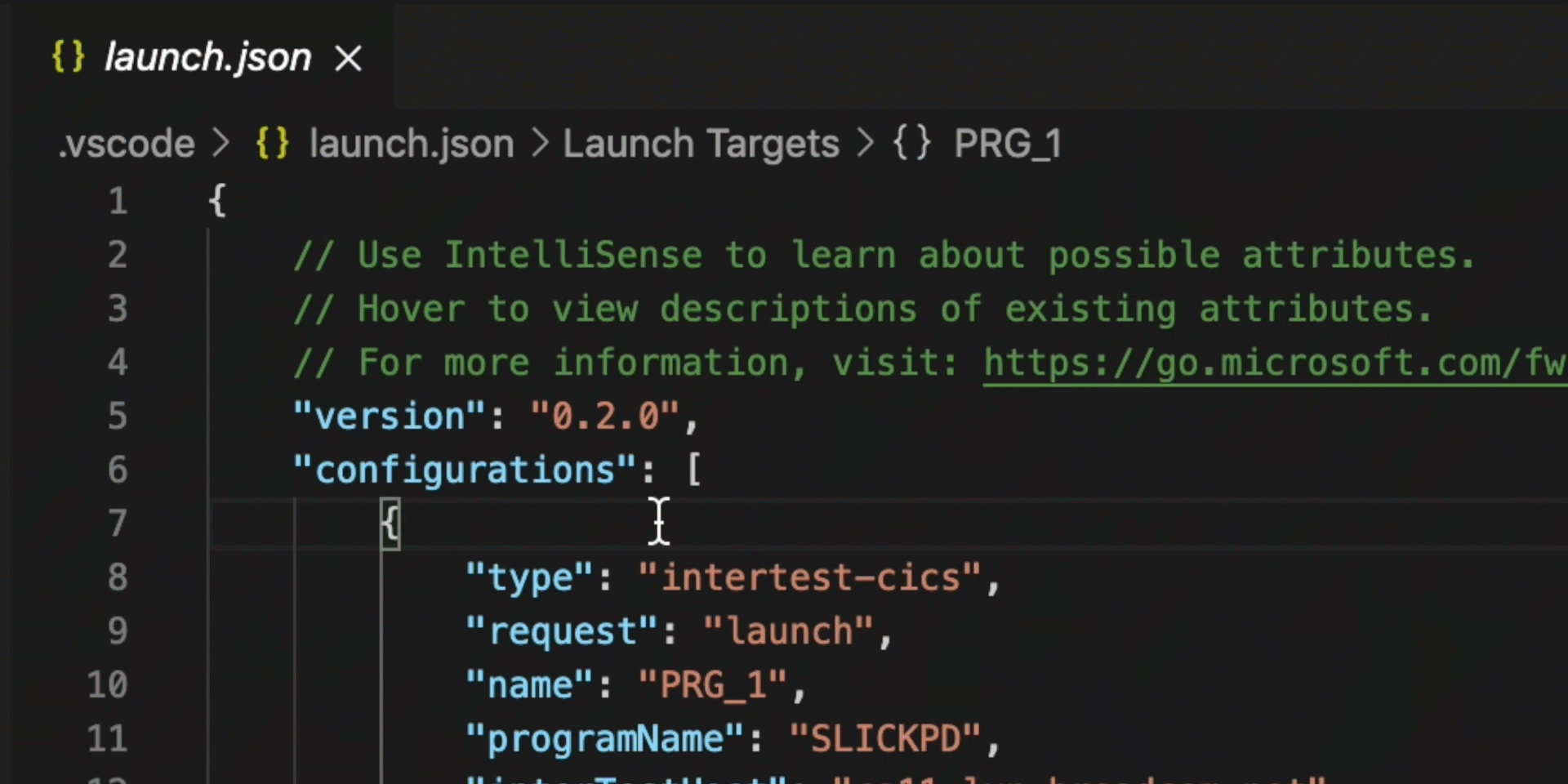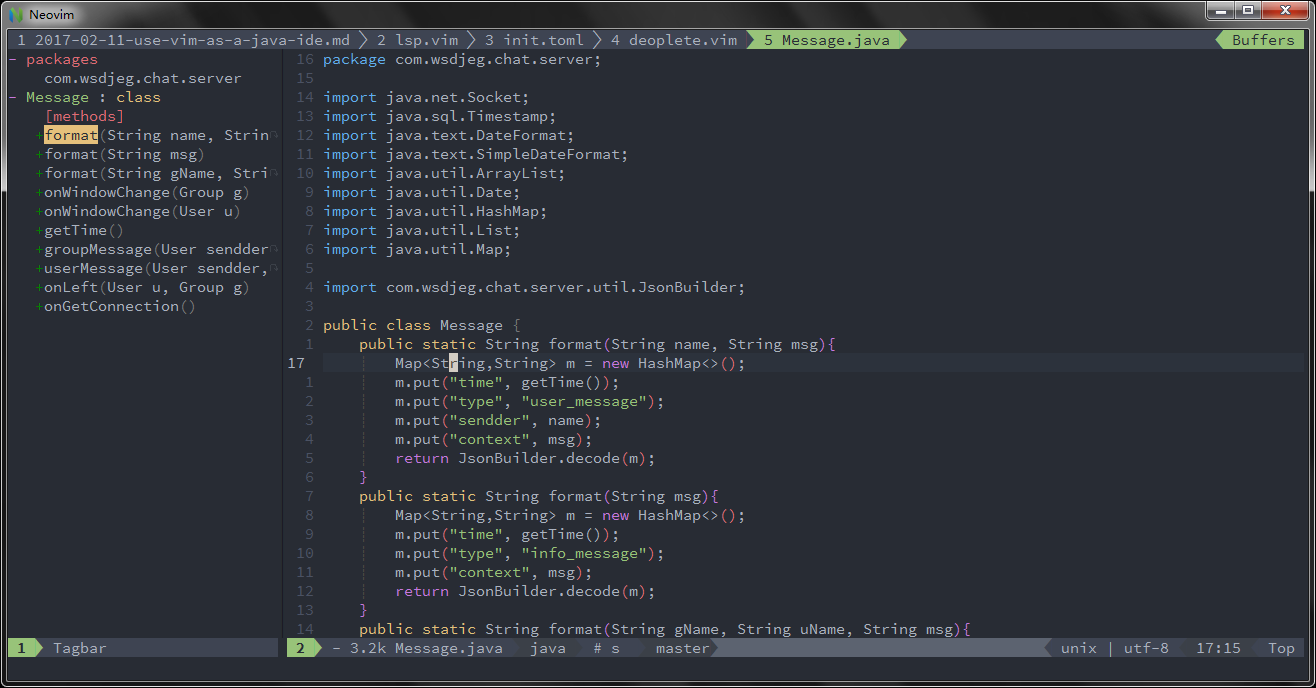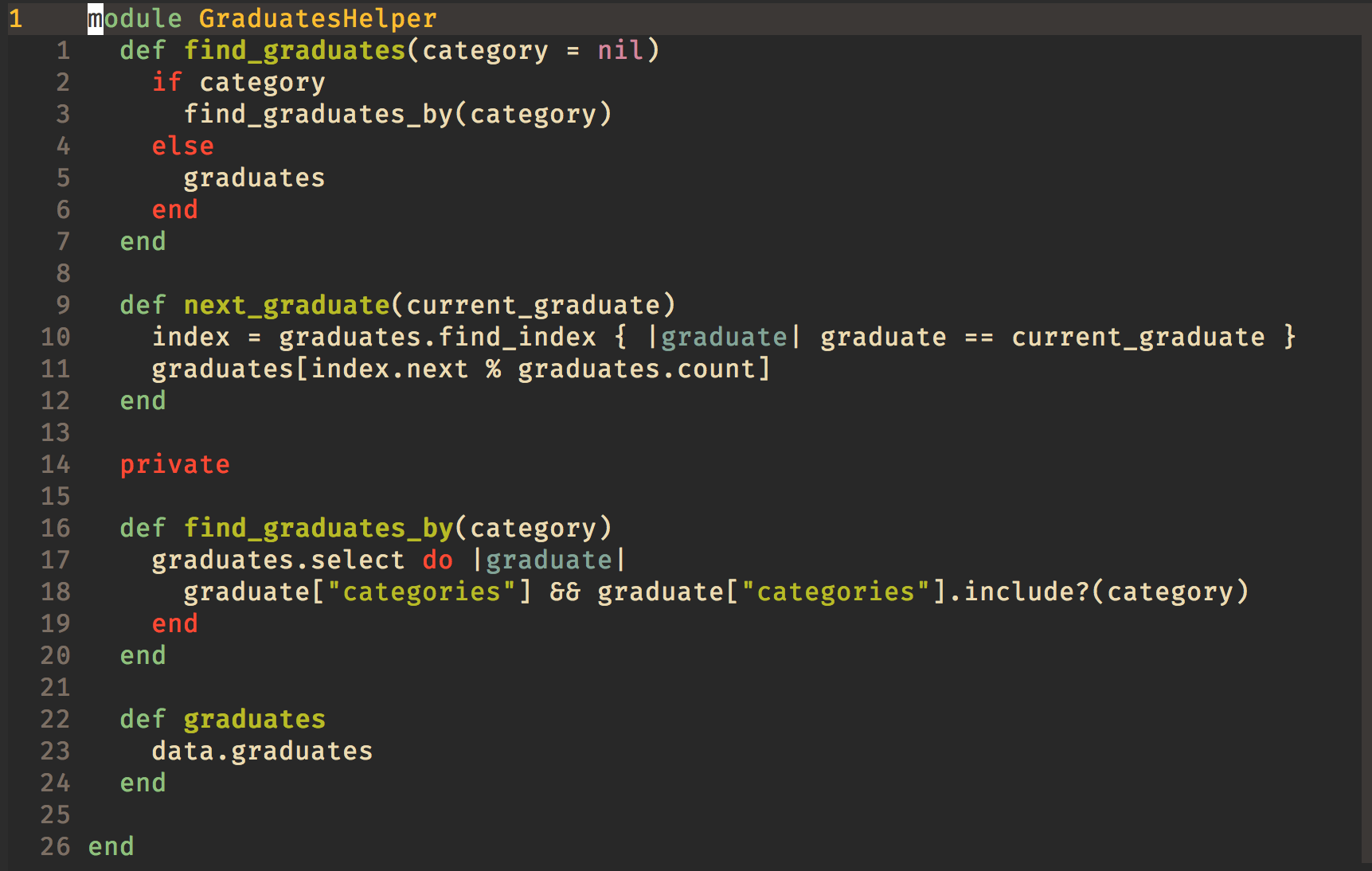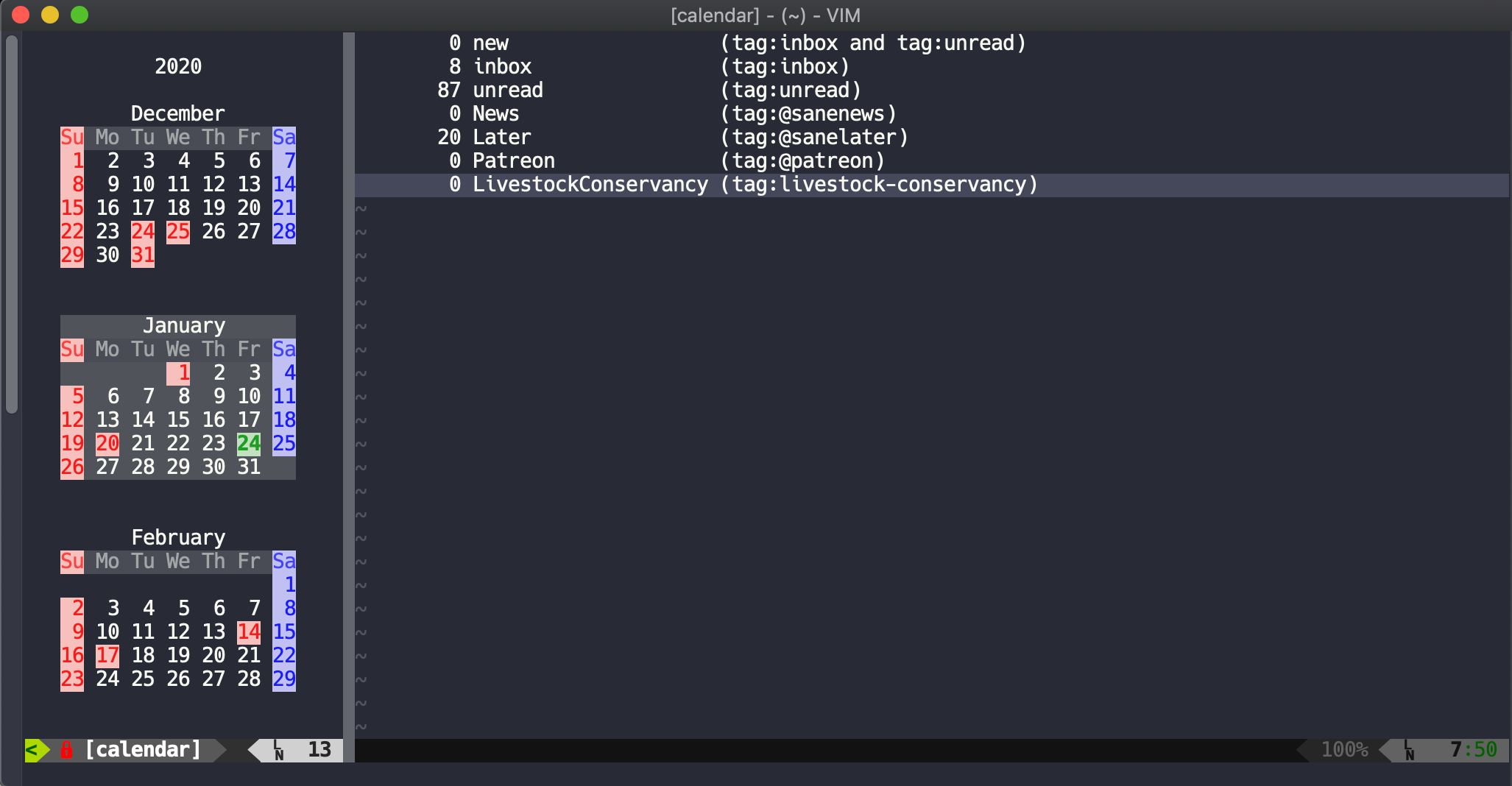- 2021-01-17: Install nvim via tar ball instead of appimage
- 2020-12-01: Add detailed guide on installing Neovim on Linux
TL;DR: My complete nvim configuration is here. Follow the guide there on how touse it. Most of the config below also applies to Windows and Mac. For how toconfigure Neovim on Windows, you may also be interested in this post.
Vundle is an excellent system built on the same principles as Pathogen, but with an integrated plugin management system that is Git and Github aware. Spf13-vim uses the Vundle plugin management system to have a well organized vim directory (Similar to mac's app folders). Vim and Tmux on your Mac Setting up your computer for Vim and Tmux often comes with a few issues. Here's how to manage plugins for Vim and use Tmux to boost your productivity, as. Plugin ' skammer/vim-css-color ' Plugin ' hail2u/vim-css3-syntax ' Plugin ' groenewege/vim-less ' Plugin ' jelera/vim-javascript-syntax ' Plugin ' cakebaker/scss-syntax.vim ' Plugin ' airblade/vim-gitgutter ' Plugin ' scrooloose/syntastic ' ' All of your Plugins must be added before the following line: call vundle#end ' required: filetype. Powerline is a popular statusline plugin for Vim that works with both Python 2 and 3. VimAwesome is a directory of Vim plugins sourced from Vim.org, GitHub and user submissions. Command-T is a Vim plugin for fast fuzzy searching files. YouCompleteMe (source code) is a code-completion engine and plugin that works for Python.
Vim is a popular code editor on Unix/Linux systems, and it is often comparedwith Emacs, another great code editoramong programmers. The debate about which one is the best editor nevercease. Vim is powerful, but it hasits own shortcomings as an old editor1. Over the years, Vim’s code base hasgrown increasing larger, which makes it hard for maintenance and for adding newfeatures quickly. It has only one core developer, Bram Moolenaar.Although Vim has a lot of contributors, nearly all patches are merged by Bram2.To overcome the shortcomings of Vim,preserve its advantages (i.e., compatible with Vim) and make the development ofVim faster, the Neovim project is created.
In this post, I will give a detailed guide on how to install Neovim andconfigure it as an IDE-like environment for Python development (in the rest ofthis post, I will use Neovim and Nvim interchangeably).
Neovim has pre-built binary package for Linux, you can download it from theNeovim GitHub release page:
The executable file is located in $HOME/tools/nvim-linux/bin/nvim.
Now, we need to add the bin directory to the system PATH. Open .bash_profileand add the following line:
Save the file and source it to make the change take effect.
Now, Neovim has been installed on your system successfully. You can open neovimon terminal with nvim command.
Neovim use a different configuration file from Vim. You need to create a filenamed init.vim under the directory $HOME/config/nvim (if this directorydoes not exist, just create one). All configurations can be put into this file.
Most of the configuration options for Neovim are the same with Vim. You cancopy your vim configurations if you have used Vim before.
One of main reasons for the powerfulness of Vim comes from the various pluginswritten for it. With these plugins, you can achieve all sorts of crazy thingswhich are hard to achieve with plain Vim. If you have installed a lot ofplugins manually, you will find it difficult to manage them. Like Vim, Neovimdoes not have a builtin plugin manager. We need to install one ourselves.
There are two plugin managers in wide use among Nvim users. One isdein and the other is vim-plug.Vim-plug has a larger user base and seems more popular. Finally, I decided togive vim-plug a try.
Install vim-plug
- Install vim-plug itself:
After installing vim-plug, you may need to restart Nvim.
- Edit
init.vimand add the configuration for vim-plug. I show an exampleconfiguration below (modified from the vim-plug GitHubpage):
Note that all the plugin installation command must be put inside the twocall command above. I will not repeat that later.
How to use vim-plug
You can execute following command in Nvim command mode:
- Install plugins:
:PlugInstall - Update plugins:
:PlugUpdate - Remove plugins:
:PlugClean(First, comment the plugin install command ininit.vim. Open Nvim and use:PlugCleanto uninstall plugins) - Check the plugin status:
:PlugStatus - Upgrade vim-plug itself:
:PlugUpgrade
Disable a plugin only temporarily
If you want to disable certain plugin for a while but do not want to delete it,you can try two methods:
Comment out the plugin and reopen Nvim.
According to discussionshere, to disable plugin
foo/bar, you can use the following settings:
Auto-completion plugin deoplete
deoplete is an auto-completionplugin designed for Neovim:
Deoplete is the abbreviation of “dark powered neo-completion”. It provides anextensible and asynchronous completion framework for neovim/Vim8.
Strictly speaking, it is an auto-completion engine. In order to enableauto-completion for a certain programming language, you need to install thecorrespondingsource.
Deoplete is easy to install. Use the following settings inside the vim-plugcalls:
The minimum setting for deoplete is as follows:
For more options and their meanings, check :h deoplete-options inside Nvim.

Install plugin deoplete-jedi
As I have said, deoplete supports auto-completion for various languages viadifferent sources. In order to do auto-completion for Python, we need toinstall deoplete-jedi. In the following, I list the steps to installdeoplete-jedi.
Step 1: Install dependency packages
First we need to install pynvim,
We also need to install jedi. If youhappen to use the latest version of Anaconda, jedi is already installed. Otherwise, you caninstall jedi via pip:
Step 2: Install and set up deoplete-jedi
First, we need to install deoplete-jedi using vim-plug:
After that, if nothing wrong happens, you can use auto-completion now! Open aPython source file with Nvim and start editing, you will see theauto-completion pop-up menu like what is shown in the following image:
How to use deoplete
- How to navigate between the items in the auto-completion list?
According to discussionshere,you can navigate through the auto-completion list with <Ctrl-N> and<Ctrl-P>.
- How to automatically close the method preview window?
When we navigate through the auto-completion list, a small window will appearon top of current window and gives hints about the parameters of currentselected method. But this window will not disappear after auto-completion isdone. According to discussions here, we can use thefollowing setting to close the preview window automatically:
- How can I open the preview window below the current window?
By default, preview windows will open on top of current window. You can changethis behaviour by adding set splitbelow in the configuration file. For moreinfo, see here.
- How can I navigate through the auto-completion list with Tab?
Add the following setting in the Nvim configuration file:
Status bar plugin: vim-airline
The default status bar of Nvim is simple and can not provide much usefulinformation like Sublime Text or other modern code editors. However, the statusbar can be customized to achieve wonderful effects. An excellent plugin iscalled vim-airline, which canachieve the same functionalities as Sublime Text status bar. It is easy toinstall:
Use :PlugInstall to install this plugin and restart Nvim. You should be ableto see the new status bar with more information displayed.
Switch vim-airlinetheme
Vim-airline provides a lot of themes for you to customize your status bar.Check here tosee what different theme looks like. Vim-airline has put the various themes inanother plugin calledvim-airlinetheme. Tochange the theme, we need to install this plugin:
Then, in the Nvim configuration file, add the following settings:
Automatic quote and bracket completion
When input quote and bracket, we often wish to input them as pairs. Nvim doesnot support this feature. Auto-pairscan achieve this and much more. Simply install it:
How to use
Let’s take manipulating double quotes as an example. In insert model, press ',it will automatically become two double quotes. At the same time, the cursor isplaced between the two double quotes, waiting for input. When you finishinputing text between the quotes, you may want to place the cursor after theright quote and continue inserting text. Here comes the magic part: just press' one more time, and the cursor will be placed right behind the right quote.
comment plugin
Different programming languages have different specifications for comment. Itwould be great to change the comment style for the current file based on itsfile type. nerdcommenter is onesuch plugin. Install it with vim-plug:
To comment out a single line, use <leader>cc (leaderis a prefix key in Nvim, the default leader key is backslash ); touncomment a line, use <leader>cu. To comment or uncomment several lines, adda repeating number to corresponding command, just like what you do in plainVim. For more usages, check nerdcommenter’s documentation.
code auto-format plugin
Neoformat can be used to format yoursource code. Install it with vim-plug:
For Python code, you need to install a Python code formatter to work togetherwith neoformat. We will choose yapf. First, we installthis formatter with pip:
Then, you can format Python code with yapf formatter using neoformat.
How to format code?
In command mode, input Neoformat, neoformat will auto-format your sourcecode.
If neoformat can not detect your file type or you haven’t installed anyformatter. You can add the following command to your Nvim configuration to letneoformat do some basic format for the file:
There is another format pluginvim-autoformat which you can try.
Code jump (go-to) plugin
We often need to jump to the definition of class and method to check theirimplementation details. We can usejedi-vim to achieve this. Actually,jedi-vim can also do code auto-completion. Since we have installed deoplete anddeoplete-jedi, we can disable code completion and only use the code jumptfunction of jedi-vim. Install jedi-vim with vim-plug:
Use the following simple configuration:
How to use jedi-vim
Move the cursor to the class or method you want to check, then press thevarious supported shortcut provided by jedi-vim:
<leader>d: go to definitionK: check documentation of class or method<leader>n: show the usage of a name in current file<leader>r: rename a name
File managing and exploration plugin
Those who have been working with GUI code editors are familiar with the sidebaron the left side of the code editor, which provides an overview of files andfolders in current project. How do we achieve similar functions in Nvim? Youcan use nerdtree. First, install it using vim-plug:
How to use nerdtree?
- How to open file navigation window?
In command mode, input :NERDTree to open the directory your current fileresides.
- How do I open a file in the file explorer?
Place the cursor in the file you want to open and press o to open this filein the right window.
- How do I switch between file window and nerdtree file navigation window?
This is the same as how you switch windows in Vim.Press ctrl and press w two times quickly to switch window. You can alsopress <Ctrl-w> and then press L.
- How do I exit or close file explorer window?
Press q while your cursor is this window? Or use NERDTreeClose command incommand mode.
For more customization, refer to this post.
Code checker plugin
Neomake is a tool for code syntax checkand build automation for Nvim. Install it with vim-plug:
Neomake’s syntax check for various languages relies on various linters. Afterinstallation, you need to install linters according to your programminglanguages. The linter for different languages are listedhere.
For Python, we can use pylint as linter. Installpylint with pip or conda:
After installing pylint, we need to set it in init.vim as the Python codechecker:
Code checking
In command mode, use Neomake command to start syntax check. We can alsoenable automatic code check. Justadd the following setting in Nvim configuration file:
Pylint checks extensively on your code, which makes it a bit slow. Another codelinter you can try is flake8, which isfaster.
Multiple cursor editing plugin
If you have used Sublime Text before, you mustbe impressed by Sublime Text’s ability to edit multiple position in the codesimultaneously. This function is great when you want to refactor your code. Youcan achieve similar function with the help ofvim-multiple-cursors. Install it with:
How to use
In normal mode, move the cursor to a variable you want to rename, press<Ctrl-N> and this variable will be highlighted. Continue press <Ctrl-N>,the next occurrence of this variable will be highlighted. If you want to skip acertain occurrence (for example, a string may contain a sub-string which is thesame as the variable), just press <Ctrl-X> after this position has beenhighlighted. Continue selecting the occurrence of this variable until all itsoccurrence has been selected.
Now, press c (in Nvim, c means to change ) and enter insert mode. Input anew name and save.
But, I should say that this plugin is not perfect. When you have a lot ofoccurrences of the variable in the file, the refactor of variable name is slow.
There are some discussions about Neovim’s native support for multiple cursors.But it seems that this function is still not finished as of today. You can findrelevant discussions in the following links:
Highlight your yank area
In Nvim, if you yank (i.e., copy) a block of text, you do not get a visual hintabout exactly what you have copied. Unless you are very familiar with Nvim, youmay have copied less or more than what you want to copy, which is annoying.With the help of vim-highlightedyank,you can now highlight the text region which you have yanked. Handy littlefeature, isn’t it?
You can install it with vim-plug:
Most of the time, you do not need any further settings after installing thisplugin. But, for some colorschemes, you will not be able to see the highlightcolors. To fix this issue, add the following setting to Nvim configuration:
If you feel that the highlight duration time is too short, you can increase thehighlight duration (measured in ms):
Code folding plugin
For large code base, it is helpful to fold some part to get a better idea ofthe structure of the code.SimplyFold is nice plugin for codefolding. Install it with vim-plug:
You do not need further settings. It works out of the box.
simple usage
There are some shortcuts to manipulate code folding:
zo: Open fold in current cursor positionzO: Open fold and sub-fold in current cursor position recursivelyzc: Close the fold in current cursor positionzC: Close the fold and sub-fold in current cursor position recursively
Before we begin
Neovim has several builtin colorschemes or themes. You may not like them andwant better themes. It is easy to install a theme. But it is little tricky tomake the theme display correctly as what the theme homepage shows. A lot ofthemes will not display well if you use an SSH client which has poor supportfor true colors. For Windows system, after trying several SSH clients, I findthat ZOC works best. For Mac, you canuse the open source tool iTerm2. To find more SSHclients which support true colors, visit thispage.
Install themes
Gruvbox is a popular Vim colorscheme.Install it with vim-plug:
Then use :PlugInstall to install it just like you install other plugins.
In Nvim configuration file, activate this theme with the following setting:
It has two modes, i.e., dark and light, which can be switched using thefollowing settings:
Restart Nvim and you will activate the new theme. It looks like the followingon my Mac:
Other themes
There are other themes you may want to try:
Unlike Sublime Text, you can not set up which font to use in Nvim’sconfiguration. Instead, Nvim will use the font you choose for your terminalemulator. So you need to set up your favorite font in the terminal. Some goodprogramming fonts are:
Check nerd fonts for more programming fonts.
There is a website called vimawesome, which collectsinformation about various Vim plugins. You can find helpful plugins on thiswebsite.

Since most Vim plugins are published on GitHub, you can also search with vimand other keywords on GitHub to find relevant plugins. For example, search vim colorschem or vim theme to find themes designed for Vim.
Neovim has support for terminal emulatorso that you can directly run a shell inside Neovim. It is handy for temporaryshell operations.
To open the terminal, use :terminal or :vnew term://bash or new term://bash. After entering the terminal, you are in normal mode. Press i tostart typing terminal command.
To exit insert mode in terminal emulator, press<Ctrl+><Ctrl+N>.
To exit terminal emulator and close the window, use exit.
Support for bracketed paste mode
Neovim has support for bracketed pastemode. The paste option in Vim isobsolete. Use :h paste and you will the following documentation:
This option is obsolete; bracketed-paste-mode is built-in.
Neovim is all nocompatible
In Nvim normal mode, use :h comatible, and you will see that:
Nvim is always “nocompatible”
For more differences between Nvim and Vim, see here.
In this part, I introduce some issues found when using Nvim and how to fixthese issue.
Nvim colorscheme does not look right inside Tmux
If your terminal supports true color, first install the latest version of tmux3,add the following config to ~/.tmux.conf (extracted from here)
Then the color should be fine. Otherwise, in the Nvim config file init.vim,use the following setting instead:
Also, there are some discussions here.
How do I get a log file when starting Neovim
Use nvim -VNUMnvim.log. NUM is used to indicate verbose level, for example:
The above command creates a log file nvim.log with verbose level 10.
More reference here. See alsonvim --help.
OK, that is end of this long post. You can find my complete Nvim configurationshere. Happy Viming!
Vim was first released in 1991. Its predecessor is Vi, born in 1978. ↩︎
Developers would send a patch to Bram. Bram will review it and then merge it on GitHub if he thinks the patch is ok. ↩︎
Check here on how to build the latest version of tmux from source. ↩︎

| MS-Windows: | Click this link to download the self-installing executable(using ftp). Signed MS-Windows files are available on thevim-win32-installer site(gvim_8.2.0012_x86_signed.exe is recommended) |
| Unix: | See the GitHub page, or Mercurial, if you prefer that.There is also anAppimagewhich is build daily and runs on many Linux systems. |
| Mac: | See the MacVim project for a GUI version and Homebrew for a terminal version |
Details and options for:
| Mirrors | Alternative sites to download Vim files from. |
| Sources | Build Vim yourself and/or make changes. |
| GitHub | Obtain Vim sources with a git client (recommended). |
| Mercurial | Obtain Vim sources with a Mercurial client(recommended if you don't like git). |
| Patches | Include the latest improvements (requires sources and rebuilding). |
| Runtime | Get the latest syntax files, documentation, etc.. |
| Script links | Links to individual syntax, indent, color, compiler and ftplugin scripts. |
| Translations | Non-English documentation packages. |
Versions before 7.3 can also be obtained withSubversionandCVS.Vim 8.2 is the latest stable version. It is highly recommended, many bugs have been fixed since previous versions.If you have a problem with it (e.g.,when it's too big for your system), you could try version 6.4 or 5.8 instead.
To avoid having to update this page for every new version, there arelinks to the directories. From there select the files you want to download.In the file names ## stands for the version number. For example,vim##src.zipwith version 8.2 is vim82src.zip andvim-##-src.tar.gz for version 8.2is vim-8.2-src.tar.gz.Links are provided for quick access to the latest version.
Note that the links point to the latest version (currently 8.2) to avoidthat caching causes you to get an older version.
You need to download at the sources and the runtime files.And apply all the latest patches.For Vim 6 up to 7.2 you can optionally get the 'lang' archive, which adds translated messages and menus. For 7.3 and later this is included with the runtime files.
The explanations are on the GitHub page.
Summary:
The explanations are on this page:Mercurial
Summary:

| The runtime and source files together: | vim-##.tar.bz2 | vim-8.2.tar.bz2 (ftp) |
The single big file ending in '.tar.bz2' is a tar archive compressed withbzip2. Uncompress and unpack it withbunzip2 -c filename | tar -xf -.
All archives should be unpacked in the same directory.
If you can't compile yourself or don't want to, look at the site of thesupplier of your Unix version for a packaged Vim executable. For Linuxdistributions and FreeBSD these are often available shortly after a new Vimversion has been released. But you can't change the features then.
- Debian packages are available at:http://packages.debian.org/vim.
- Sun Solaris Vim is included in the Companion Software:http://wwws.sun.com/software/solaris/freeware/.
Vim for other Sun systems can be found athttp://sunfreeware.com/. - HPUX with GTK GUI for various HPUX versions:http://hpux.its.tudelft.nl/hppd/hpux/Editors/vim-6.2/ orhttp://hpux.connect.org.uk/hppd/hpux/Editors/vim-6.2/ (note that the remark about the GNU GPL is wrong)
gvim82.exe (ftp)
It includes GUI and console versions, for 32 bit and 64 bit systems.You can select what you want to install and includes an uninstaller.
If you want a signed version you can get a build from
vim-win32-installer
It supports many interfaces, such as Perl, Tcl, Lua, Python and Ruby.There are also 64bit versions which only run on 64 bit MS-Windows and use alot more memory, but is compatible with 64 bit plugins.
You can also get a nightly build from there with the most recent improvements,with a small risk that something is broken.
Since there are so many different versions of MS operating systems, there areseveral versions of Vim for them.
For Vim 5.x, Vim 6.x and Vim 7 look inthe pc directory (ftp).

- Self-installing executable gvim##.exe gvim82.exe (ftp)
- For Vim 6 and later. This includes a GUI versionof Vim - with many features and OLE support - and all the runtime files.It works well on MS-Windows 95/98/ME/NT/2000/XP/Vista/7.Use this if you have enough disk space and memory. It's the simplest way tostart using Vim on the PC. The installer allows you to skip the parts youdon't want.
For Vim 6.3 and later it also includes a console version, both for MS-Windows 95/98/ME and MS-Windows NT/2000/XP/Vista/7. The installer automatically selects the right one.
- Runtime files vim##rt.zip vim82rt.zip (ftp)
- For all the following binary versions you need this runtime archive, whichincludes the documentation, syntax files, etc. Always get this, unless youuse the self-installing executable.
There are three versions that run as an MS-Windows application. These providemenus, scrollbars and a toolbar.
- GUI executable gvim##.zip gvim82.zip (ftp)
- This is the 'normal' GUI version.
- OLE GUI executable gvim##ole.zip gvim82ole.zip (ftp)
- A GUI version with OLE support. This offers a few extra features,such as integration with Visual Developer Studio. But it uses quite a bitmore memory.
- Win32 console executable vim##w32.zip vim82w32.zip (ftp)
- The Win32 console version works well on MS-Windows NT/2000/XP/Vista/7. It supports long file names and is compiled with 'big' features. It does not runperfectly well on MS-Windows 95/98/ME, especially when resizing the consolewindow (this may crash MS-Windows...).
- 32 bit DOS executable vim##d32.zip vim73_46d32.zip (ftp)
- The 32 bit DOS version works well on MS-Windows 95/98/ME. It requires a DPMImanager, which needs to be installed on MS-DOS. MS-Windows already has one.It supports long file names, but NOT on MS-Windows NT/2000/XP/Vista/7. It is compiled with 'big' features.
Not available for 7.4 and later. - 16 bit DOS executable vim##d16.zip vim71d16.zip (ftp)
- The 16 bit DOS version is the only one that runs on old MS-DOS systems. Onlyuse this if you are really desparate, because it excludes many useful features(such as syntax highlighting and long file names) and quickly runs out ofmemory.
The last version available is 7.1. Version 7.2 and later are too big to fit in the DOS memory model.
- iconv librarylibiconv
- A library used for converting character sets.Put 'iconv.dll' in the same directory as gvim.exe to be able to edit files inmany encodings. You can find the dll file in the bin directory of the'libiconv-win32' archive.
- newer intl librarylibintl
- The included libintl.dll does not support encoding conversion.If you have installed the iconv library, as mentioned above, you can install agettext library that uses it.Get 'intl.dll' from the bin directory in the gettext-win32 archive and store itas 'libintl.dll' in the same directory as gvim.exe, overwriting the filethat may already be there.
- PC sources vim##src.zip vim82src.zip (ftp)
- The source files, packed for the PC. This only includes the files needed onthe PC, not for other systems. The files are in dos format CR-LF.
- PC debug files gvim##.pdb gvim82.pdb (ftp) gvim##ole.pdb gvim82ole.pdb (ftp) vim##w32.pdb vim80w32.pdb (ftp)
- When you notice a bug or a crash in Vim these files can be used to help tracing down the problem. In Vim 7 do ':help debug-win32' to see how.
- PC translations vim##lang.zip vim72lang.zip (ftp)
- Only for 7.2 and earlier, for 7.3 and later these are included in the 'rt' archive.Translated messages and menu files, packed for the PC. Use this to seenon-English menus. The messages are only translated when the libintl.dlllibrary is installed.
- Windows 3.1 GUI executable gvim##w16.zip and gvim##m16.zip
- These are GUI versions for 16 bit windows (Windows 3.1). The 'w16' has manyfeatures, 'm16' has few features (for when you're short on memory).
Alternate distributions
- Yongwei's build
- You may also try Yongwei's build,executables with slightly different interfaces supported.
- Cream
- For an unofficial version that used to include all the latest patches andoptionally a bitmore: Cream.The 'one-click installer' mentioned includes the Cream changes.For the 'real Vim' use the 'without Cream' version listed further down.
Unfortunately, it stopped updating since Vim 8.0.
Mac Vim Plugins Free
- Cygwin
- For a Cygwin binary look at others.
For Vim 5.x and Vim 6 look inthe amiga directory (ftp).
Vim 7 files can be found atos4depot.net. This is for AmigaOS 4. Made by Peter Bengtsson.
- Runtime files vim##rt.tgz vim64rt.tgz (ftp)
- Documentation, syntax files, etc. You always need this.
- Executable vim##bin.tgz vim64bin.tgz (ftp)
- The executables for Vim and Xxd.For Vim 6 it includes 'big' features, for Vim 5.x itincludes the normal features.For Vim 6.2 it is not available (my Amiga had harddisk problems then, this miraculously healed later).
- Big executable vim##big.tgz
- Vim with 'big' features and Xxd. Only for Vim 5.x.
- Sources vim##src.tgz vim64src.tgz (ftp)
- The source files for the Amiga.Only needed when you want to compile Vim yourself.
For Vim 5.x and Vim 6 look inthe os2 directory (ftp).Version 6.2 is not available.Versions 6.3 and 6.4 were compiled by David Sanders.
Version 7.0 was compiled by David Sanders.
- Runtime files vim##rt.zip vim70rt.zip (ftp)
- Documentation, syntax files, etc. You always need this.
- Executables vim##os2.zip vim70os2.zip (ftp)
- Vim, Xxd, Tee and EMX libraries.
If you want to compile the OS/2 version, you need the EMX compiler. Use theUnix source archive, runtime files and the extra archive. After unpacking theruntime archive, move all the files and directories in the 'runtime'directory one level up.
The terminal version of Vim is included as 'vi', you already have it. It'slagging behind a bit though and has limited features, thus you may want toadditionally install a recent version or one with more features.MacVim
There most popular version is MacVim. This is being actively developed. Thisbehaves like a Mac application, using a GUI.MacVim has more a Mac look and feel, is developed actively and most peopleprefer this version. Most of MacVim was made by Björn Winckler.
MacVim can be downloaded here: https://github.com/macvim-dev/macvim
New versions are made quite often.Subscribe to thevim-mac maillistto be informed about bugs and updates.
Homebrew
This is a terminal version installed with the 'brew' command.It is updated frequently.It can be downloaded here: formulae.brew.sh/formula/vim.Older
Older binaries for Mac OS/X can be found on thisSourceForge project.Maintained by Nicholas Stallard.
Here is a multi-byte version of Vim 5.7 (for Japanese, possibly also forKorean and Chinese; not for Unicode):
http://www-imai.is.s.u-tokyo.ac.jp/~asai/macvim-e.html
Mac Vim Plugin Manager
Background
Most of the work forthe Macintosh port (Classic and Carbon) was done by Dany St-Amant.
If you have OSX and a setup for compiling programs, you can use the source codeand compile yourself. See the Unix section above. The development tools can bedownloaded from Apple's developer web site.
Turn to the vim-mac maillist to meet otherVim-Mac users.
This is a list of links to sites where various versions of Vim can be obtained.These are supported by individuals, use at your own risk.Mac Vim Plugin
| Android | Search for 'Vim Touch' by Momodalo in the Play Store. |
| i/OS | Run Vim on your iPhone or Ipad. |
| QNX (ftp) | Provided by Yakov Zaytsev. Requires QNX 6.3.0/6.3.2 with service pack 2. |
| Agenda | http://pi7.fernuni-hagen.de/hartrumpf/agenda/vim/vim.vr3 |
| Cygwin (with GTK GUI) | http://lassauge.free.fr/cygwin/ |
| Open VMS | http://www.polarhome.com/vim/ |
| MorphOS | http://www.akcaagac.com/index_vim.html |
Mac Vim Plugins List
TOP
